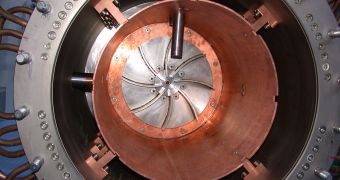It is known that the Earth's molten metal core fuels a magnetic field.
Now, a team has generated similar self-sustaining fields even when the flow is highly turbulent.
The new approach is a closer simulation of the Earth's dynamo than other experiments as the fluid flows freely in a large tank and is not channeled into prescribed patterns with tubes.
This experiment could offer a better knowledge of the factors that induce magnetic fields in planets and stars. The Earth's core, a mix of iron and nickel with internal flows driven by heat, generates magnetism by means of self-sustaining feedback.
Liquid metal moving through a magnetic field induces a current, like that formed in the moving coil of an electric generator that fuels the magnetic field. The "self-generation" pattern increases significantly the small, random fields found in magnetic materials.
To achieve this, the flow must be both complex, combining the longitudinal and latitudinal directions, and rapid, "tangling up" magnetic field lines quicker than they can untangle.
In 2000, two teams forced liquid sodium into complex but non-turbulent flows employing physical barriers that headed the fluid along precise paths.
Now the French VKS collaboration has made a self-generating magnetic field with a less modelled flow. They mounted disks presenting curved vanes at each end of a half-meter (1.6 ft) long cylindrical tank filled with liquid sodium. When these "propellers" rotate in opposite directions at a rhythm of 26 revolutions per second generating a turbulent flow that determined the emergence of a magnetic field.
The field was generated only when the propellers were made of iron, a metal that modifies the field close to its surface. "The flow is less constrained geometrically, but it's not as free as in Earth's core or in other planets, stars, or galaxies with magnetic fields", said team member St?phan Fauve of the ENS in Paris.
The spontaneous field was created even when the average flow speed inside the liquid was remarkably low, that that took by surprise the researchers as they expected a much higher speed to be required, because other experiments pointed that turbulence would increase the "untangling" rate for field lines and destroy the dynamo effect. (The Earth's dynamo is turbulent but works at a much higher effective speed.) "This is the first time a magnetic field is self-generated by a fully turbulent flow with turbulent fluctuations as large as the mean flow," said Fauve.
"There is a real advance here," said Cary Forest of the University of Wisconsin at Madison, who also explores magnetic fields arising in turbulent sodium flow.
"The turbulent eddies in this experiment are almost as big as the experimental cell itself, whereas the eddies of molten metal that give rise to Earth's magnetism are much smaller than the core. It would be interesting in the future to have an experiment where one had turbulence at small scales driving a magnetic field at large scales," he said.

 14 DAY TRIAL //
14 DAY TRIAL //